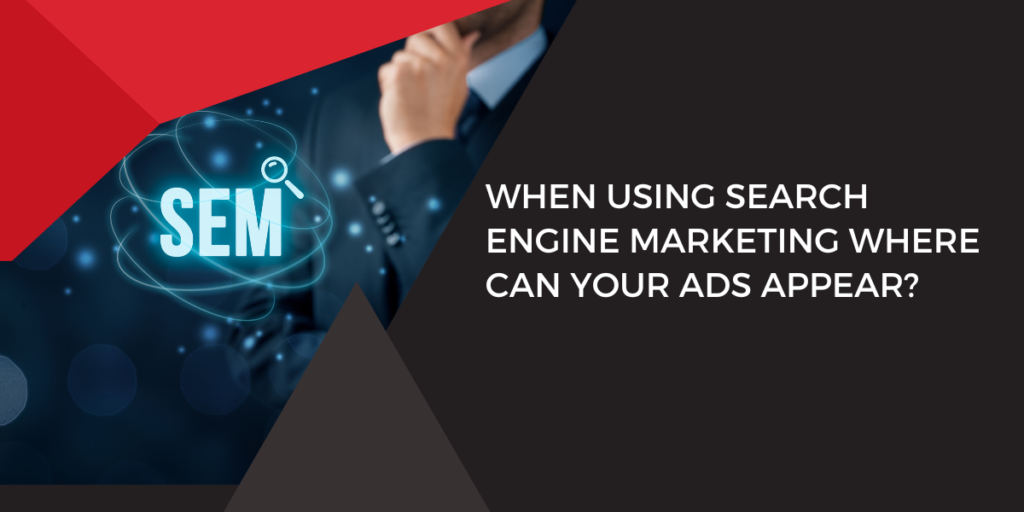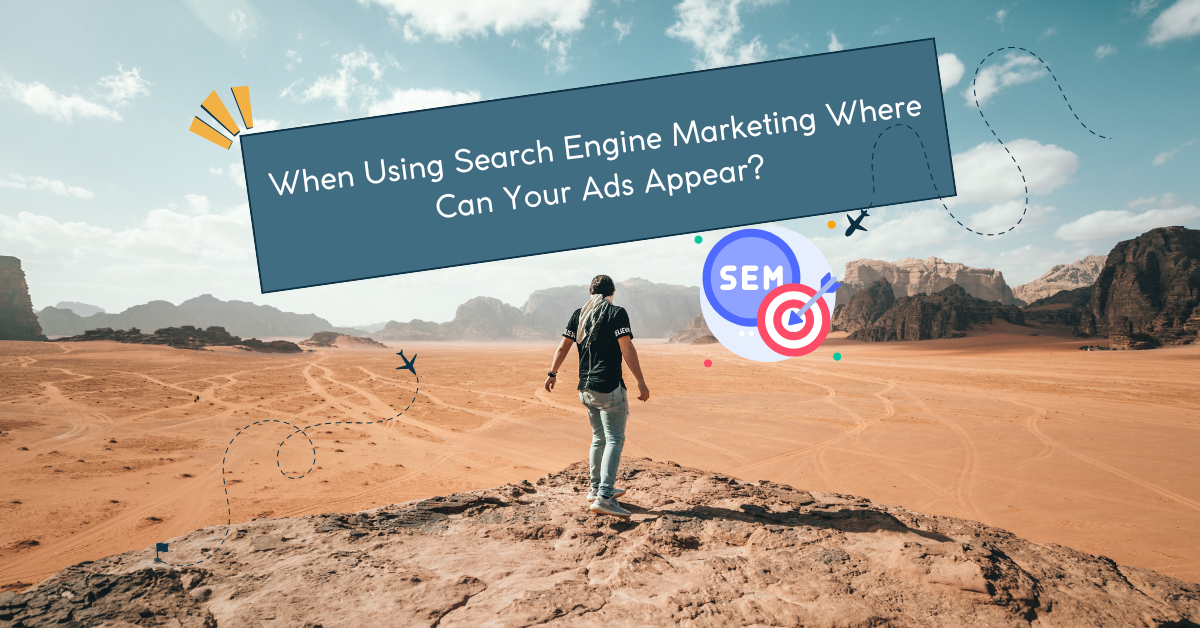Search Engine Marketing. In today’s digital landscape, getting your business in front of potential customers is more accessible than ever. But where exactly can your ads show up? This article will outline all the various places your ads can appear when using search engine marketing (SEM).
Search engine marketing is a great way to connect with your target audience effectively. Clients often ask us where their ads will show up. The answer varies depending on your business needs. Generally, it’s beneficial to place ads on Google, Yahoo, Bing, and other major search engines, as well as relevant pages related to your business.

Definition of SEM
SEM stands for search engine marketing. It’s a way to advertise online and connect with potential customers. SEM helps find new customers and boost website traffic. It’s an essential part of digital marketing to increase sales and generate leads.
What does search engine ad refer to?
A search engine ad is an online ad that shows up as a sponsored link on a search engine results page (SERP). These ads, also called sponsored links or pay-per-click (PPC) ads, are separate from organic search results, which are unpaid and based on algorithms.
What does Search Engine Marketing typically cost?
SEM costs can vary based on your industry, how competitive your keywords are, and the methods you choose. Generally, SEM expenses include ad spending, maintaining your website, and acquiring customers.
For best results, combine paid and organic methods. Organic SEM includes SEO and social media, while paid SEM covers ads on search engines, social platforms, and websites.
What does SEM aim to achieve?
SEM aims to connect with potential customers and promote products or services. It’s about finding new customers and boosting website visits.
A key goal of SEM is to enhance user experience. This includes using relevant keywords, improving visual content, and optimising website content.
Matching the ad message with the landing page is crucial to avoid confusing users, reducing bounce rates, and maximising ad effectiveness.
What types of ad formats are commonly used in SEM?
SEM uses various ad formats, including text, image, video, and rich media. However, the most common formats for SEM are text ads and image ads.
Text ads are budget-friendly and use text to attract customers.Image ads, also known as banner ads, are highly effective in grabbing attention and promoting your brand. They can go viral and generate significant attention with minimal ad spend.
What is the Goal of the SEM?
The main Goal of SEM is to connect with potential customers and promote products or services. It’s also about finding new customers, boosting website traffic, and discovering fresh leads for your business. SEM is cost-effective compared to many other advertising methods, making it a valuable tool for businesses.
Where do your ads typically appear?
The placement of your ads varies depending on the search engine. However, all ads are marked with a small label indicating they are sponsored. In Yahoo and Bing, ads appear at the bottom of the page, while Google displays them at the top of the search results.
How Does it show?
The ad includes key elements like:
1. Headline: This showcases your main offering. A search engine marketing company strategically uses relevant keywords in headlines to maximise reach and ROI.
2. Display URL: This provides users with a clear picture of the domain, sub-domain, and path fields they will navigate when clicking the ad.
3. Description: This section explains more about the product or service being advertised. It’s crucial to include enough keywords here to improve your ad’s placement.
4. Ad Extensions: Google provides ad extensions that enable users to take additional actions such as calling, messaging, or visiting specific pages like contact or order forms.
What are some other factors that can affect where your ad appears?
Other factors that can influence your ad’s positioning include:
Quality Score: Google rates your ad and landing page based on user experience factors like content relevance, CTA placement, image optimization, UI/UX, readability, and usability. Aim for a quality score of at least 3 to improve ad placement.
landing page: Designing an interactive landing page is crucial for SEM success. Your landing page should reflect current trends and user preferences, with interactive design elements and customer-centric messaging. Focus on providing value to customers and showcasing what they can gain from your product or service. This approach will not only attract leads but also lead to revenue growth.
Overall domain authority:User emphasises the importance of overall domain authority in SEM, which contributes to wider reach among target audiences. They highlight the need for comprehensive SEM packages that optimise both organic and paid efforts.
Keywords Consideration: When setting up SEM campaigns, create separate ad groups for different products or services. Choose medium-intensity keywords to improve quality scores and reach more people. Research your audience’s preferences to create compelling ad content.
Hiring an expert for SEM campaigns is essential because of the complexity involved. A trusted service provider can greatly increase your ROI. At robes, we’ve consistently achieved seven times the ROI for clients across different industries. Get in touch with us to surpass your SEM expectations.
SEM is a valuable method for connecting with potential customers and promoting products or services effectively. There are diverse ad formats available to engage various customer segments. It’s crucial to keep the campaign’s objectives in mind and understand the target audience thoroughly. Selecting the appropriate ad format and content is key to crafting an impactful and well-received advertisement.
FAQS-
Where do search engine marketing ads typically show up?
SEM ads typically appear at the top or bottom of search engine results pages (SERPs) and are generated by specific keywords related to the offerings.
Where Can Google Video Ads Appear?
- Mobile web:
- Outstream ads can appear in banners on mobile web pages.
- Mobile apps:
- Outstream ads may appear in banners, interstitials, in-feed placements, and native formats within mobile applications.
- They can also appear in both portrait and fullscreen modes on mobile devices.
- Desktop:
- On desktop devices, video ads can appear as part of YouTube videos, either as skippable or non-skippable ads before, during, or after the main video content.
- Video ads can also be displayed on other websites within Google’s video partner network, typically within video players or as interstitial ads.
Overall, Google video ads have a broad reach across mobile and desktop platforms, including websites and apps within Google’s video partner network.
What is an Example of SEM?
Google Ads, formerly known as Google AdWords, is a prime example of search engine marketing (SEM). Advertisers use Google Ads to bid on specific keywords relevant to their products or services. When users search for those keywords on Google, the ads of the highest bidders or those with the most relevant and engaging content appear prominently on the search results pages. This method allows businesses to target potential customers actively searching for what they offer, making it a highly effective advertising strategy.
When did SEM start?
That’s a great historical perspective on the origins of search engine marketing (SEM)! OpenText Corporation indeed played a crucial role in pioneering pay-per-click (PPC) ads, which laid the foundation for SEM as we know it today.
The formal recognition of SEM as a marketing strategy in 2001 further solidified its importance in the digital advertising landscape.
Also Read,
https://digimarketinggyan.com/is-digital-marketing-a-good-career/

